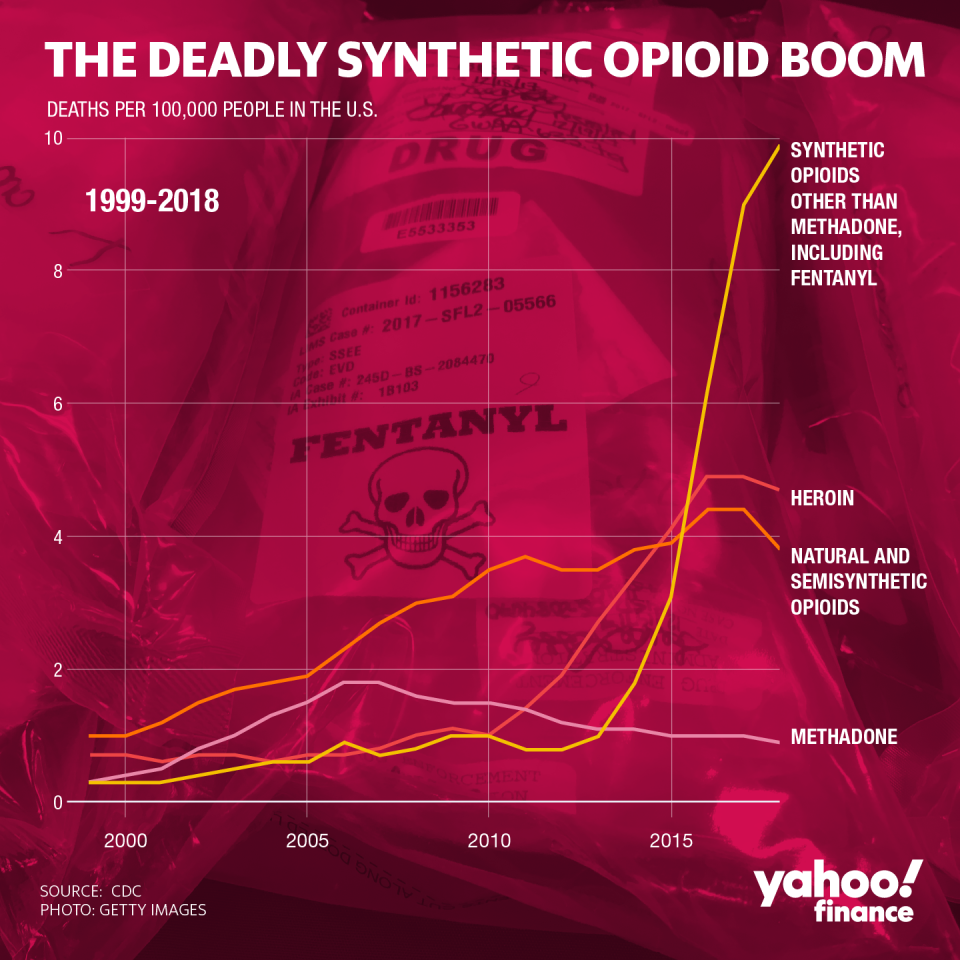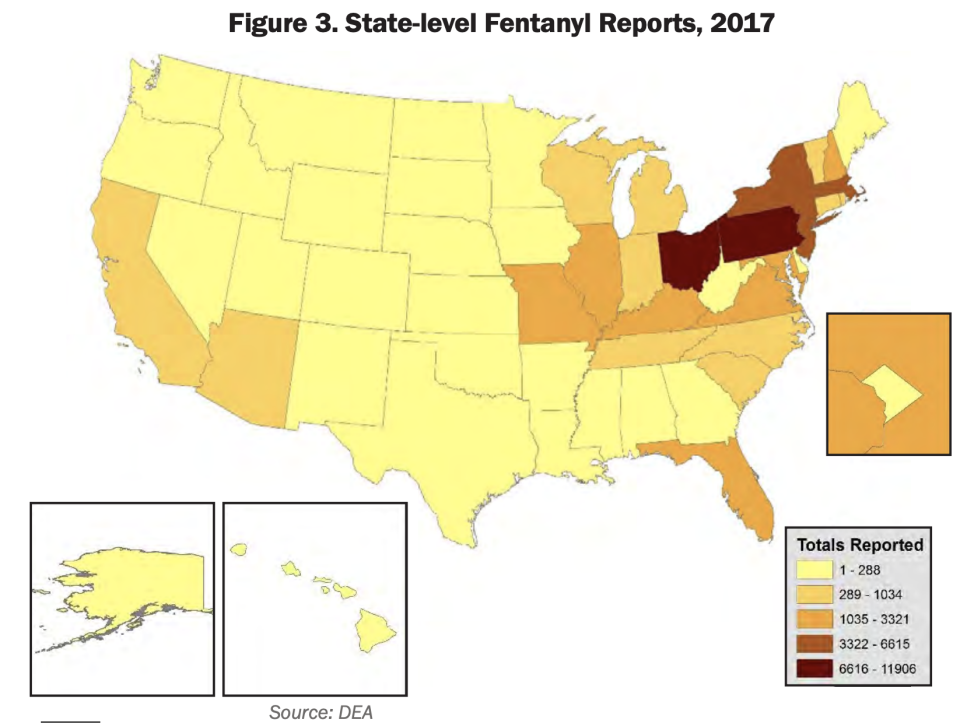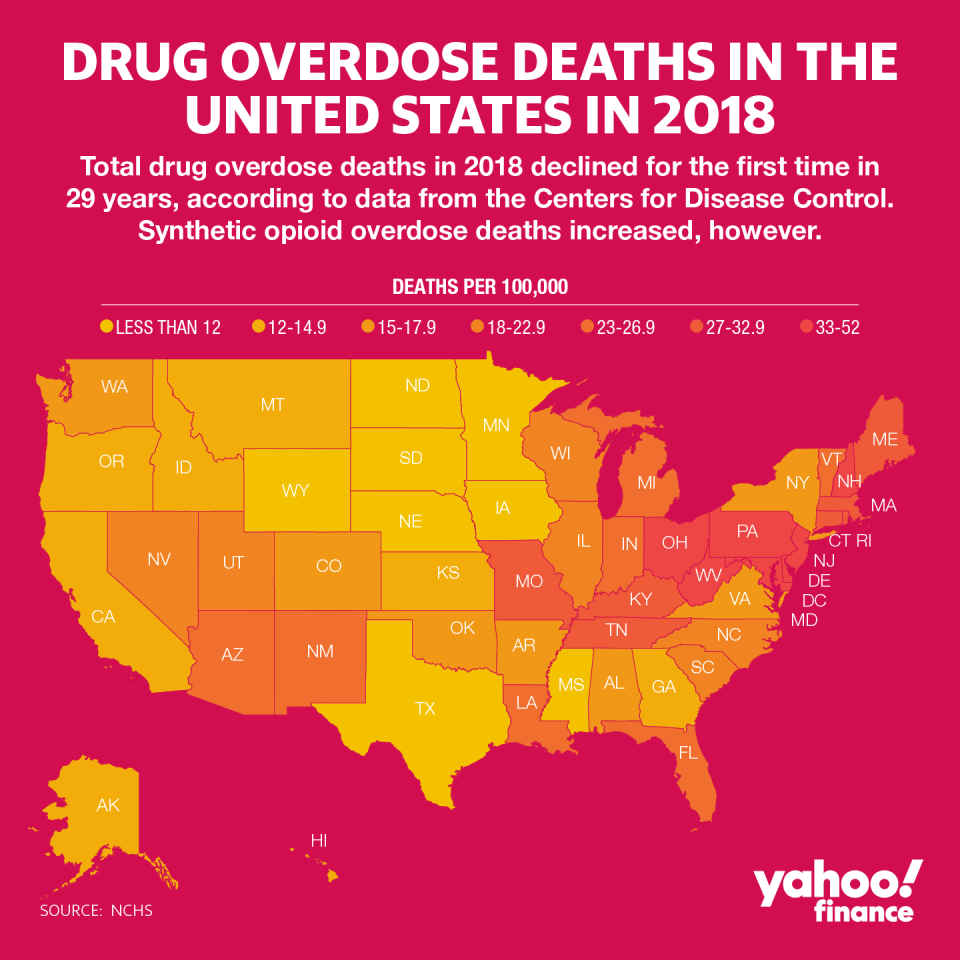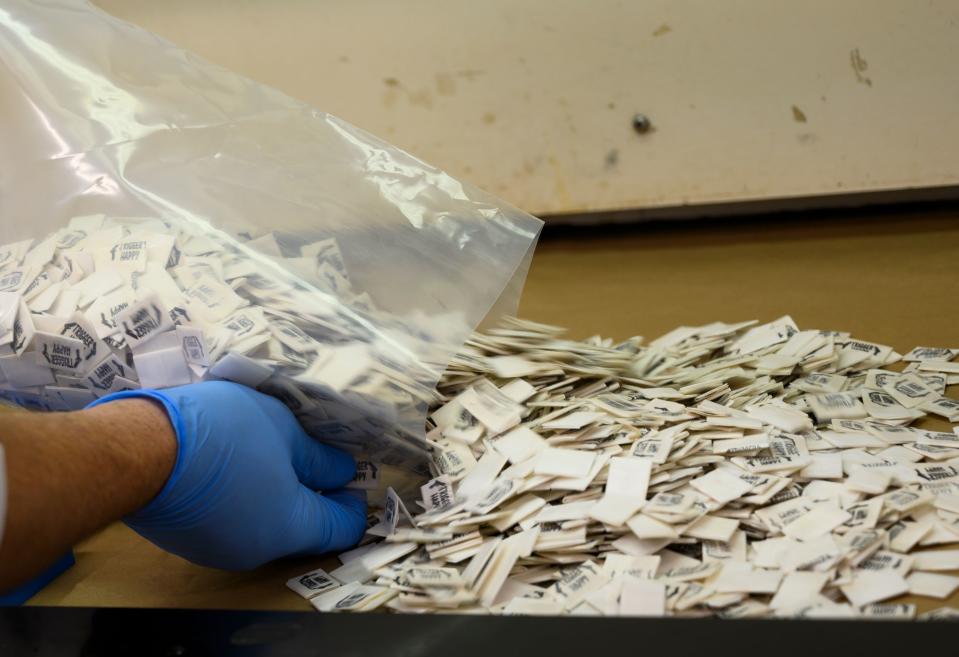DEA: The U.S. opioid crisis is 'ever-increasing'
For the first time in 29 years, drug overdose deaths are on the decline, according to data from the Centers for Disease Control (CDC).
But overdose deaths from synthetic opioids were still on the rise.
“The opioid threat (controlled prescription drugs, synthetic drugs, and heroin) continues at ever-increasing epidemic levels, affecting large portions of the United States,” the Drug Enforcement Agency (DEA) stated in its 2019 National Drug Threat Assessment.

The report specifically named fentanyl as “the primary driver behind the ongoing opioid crisis.” Synthetic opioids like fentanyl accounted for nearly 70% of all drug overdose deaths in 2018.
“Really at its core, what we have is an addiction crisis,” Jim Carroll, the director of the U.S. Office of National Drug Control Policy, told Yahoo Finance. “This is really different from where this was 20 or 30 years ago, when I started my career as a drug prosecutor, criminal prosecutor, mainly during drug cases, and that people either had an addiction to cocaine or to heroin.”
He added that the “rise of fentanyl, imported illicitly into the U.S. over the last eight years or so, has just been dramatic.”

‘There’s more work to be done’
President Trump celebrated the decline in overdose deaths during his 2020 State of the Union address. But Sheila Vakharia, the deputy director of the Department of Research and Academic Engagement at Drug Policy Alliance, said it’s “too soon for a victory lap.”
“It’s important to acknowledge it when we see these reductions because these are real human lives,” she told Yahoo Finance. “When we see that we haven’t lost as many in previous years, we have to acknowledge that perhaps we are doing something right.
“But we’re at this point where we are still losing tens of thousands of lives a year. 57,000 deaths is still too many. It tells us there’s more work to be done.”

Fentanyl is still a major player at hand. The DEA report stated that the drug’s availability throughout the U.S. in 2018 was “high and increasing,” indicating that it’s rapidly spreading. The street fentanyl is primarily from China or Mexico and is particularly prevalent in regions like the Great Lakes, the Midwest, and the Northeast.
“There are new source and transit countries emerging as important players in the fentanyl threat,” according to the DEA report. China has made regulatory steps to curb fentanyl production. The DEA predicts, though, this will lead to India and Mexico ramping up their own operations.
‘Harsher penalties aren’t going to get drugs off of our streets’
Prescription drugs, which led a previous wave of the opioid crisis, are still an issue. CDC data shows that there were 17,029 prescription opioid-involved fatal overdoses in 2017 — about 47 people a day. The states with the highest rates of these deaths were West Virginia, Maryland, Kentucky, and Utah.
After a wave of new government regulations, stricter prescribing guidelines, and lower production quotas set by the DEA, number of prescription opioids available in 2018 dropped to its lowest level since 2006.
“There are a few things that the federal government has done right in that we have increased federal funds that had been released to the states to implement strategies to address the overdose crisis,” Vakharia said. “And in some situations, they could use that money wisely and it’s increasing their capacity to help support people who use drugs and get them the help they need.”
And fentanyl is still a growing problem.
“What we’re seeing here is that overdose death rates continue to go up involving fentanyl,” Vakharia said. “These harsher sentences, these harsher policies, these harsher crackdowns in an attempt to get tougher on fentanyl isn’t actually saving lives. I think that’s a really important point that we need to highlight — that harsher penalties aren’t going to get drugs off of our streets or they’re going to get fentanyl off our streets. But what we do need to do is turn around and focus more on treatment and harm reduction.”

‘Fentanyl will remain a serious threat to the United States’
During the final days of President Obama’s presidency, the White House declared fentanyl a national crisis. After President Trump took office, his administration took aggressive steps towards addressing rising fentanyl addiction, including using police dogs at ports of entry to sniff out drugs being smuggled into the country.
“Since President Trump took office, he has made this one of his priorities,” Carroll said. “President Trump, we believe, was the first president to ever mention fentanyl and as you can see, he’s made it a priority.”
President Trump's administration has implemented several policies to curb opioid addiction. These include declaring the opioid crisis as a “public health emergency,” expanding access to naloxone, working with China to stop the flow of fentanyl, and setting restrictions on opioid prescriptions.
Vakharia argued that the government needs to do more, such as increasing access to buprenorphine and methadone. The drugs are “the two gold standards that we know for opioid use disorder than can reduce the overdose rate in half among people who use them,” Vakharia said. “And right now, there’s really tight federal restriction on both methadone and buprenorphine so that it makes it harder to get them in the hands of people who use drugs.”

Back in October 2018, President Trump signed the Substance-Use Disorder Prevention that Promotes Opioid Recovery and Treatment (SUPPORT) for Patients and Communities Act, which one expert described to Yahoo Finance as “historic in its breadth.” Although the bill was widely praised, several experts noted that the bill still made it difficult for doctors to prescribe buprenorphine, a type of medication-assisted treatment used for people in recovery.
“Increasing access to medication, allowing us to open safer consumption spaces, continuing to help us increase access to Naloxone,” Vakharia said about how the federal government can step in. “Because we do know that a lot of states have increased access to naloxone, the overdose reversal drug, because of federal funds that they’ve gotten, so that’s a good thing.”
Still, she said, “fentanyl continues to be a driver of this overdose crisis, and it’s involved in a significant number of overdose deaths every year.”
The key is for the federal government to use allocated funds wisely as more is learned about the drug.
Until then, the DEA report stated, “fentanyl will remain a serious threat to the United States.”
Adriana is an associate editor for Yahoo Finance. She can be reached at [email protected]. Follow her on Twitter @adrianambells.
READ MORE:
How China flooded the U.S. with lethal fentanyl, fueling the opioid crisis
Expert: Democrats are still not talking enough about opioids
Read the latest financial and business news from Yahoo Finance
Follow Yahoo Finance on Twitter, Facebook, Instagram, Flipboard, SmartNews, LinkedIn, YouTube, and reddit.
